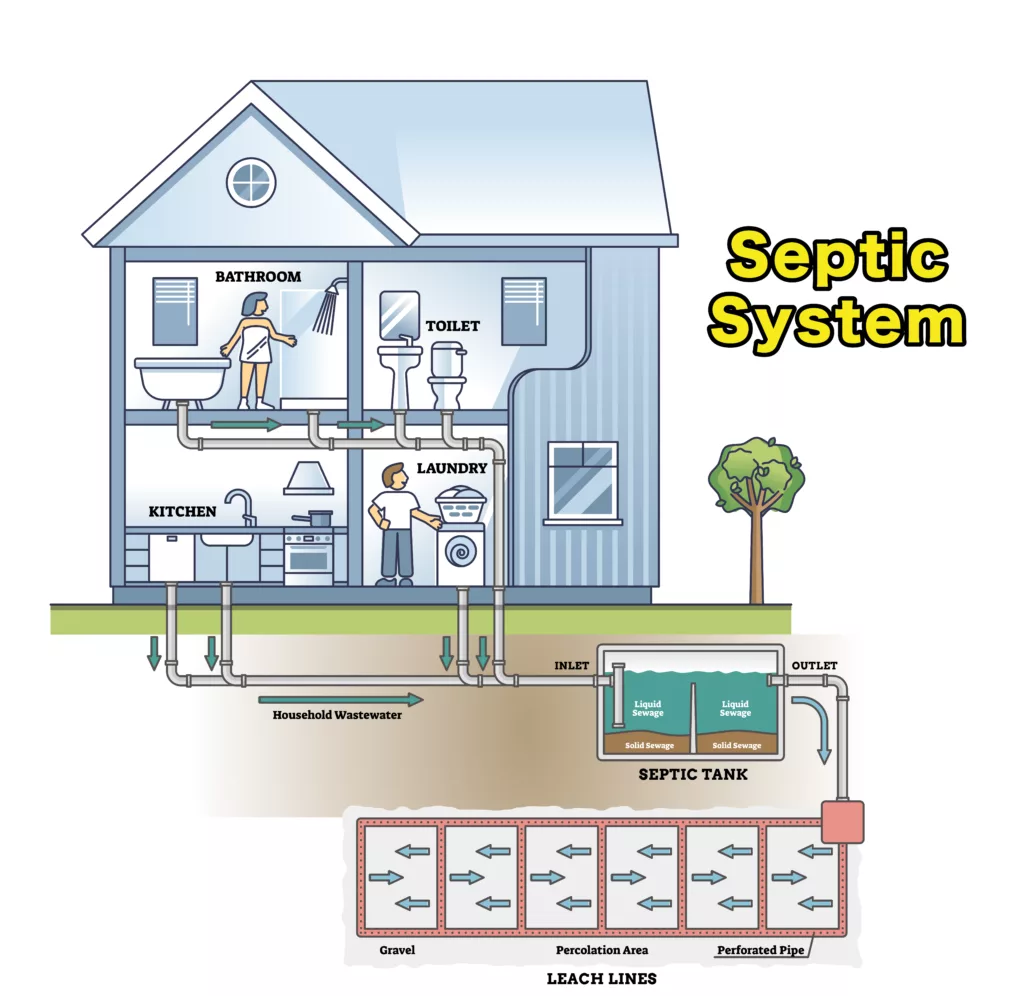In numerous homes far from urban centers, septic systems efficiently and eco-friendly process waste. This decentralized system is an essential part of maintaining sanitation and hygiene. While the plumbing experts here at Small Jobs Plumbing, Inc. – your sewer rooter specialists – do not drain or install septic tanks or leach lines, there are tasks we can help with.
If you are looking for help with drain line back-ups for empty tanks, replumbing drain lines that lead to your septic system, or installing or replacing grinder and ejection pumps, our team can help! Let’s delve deeper into a septic system’s functionalities and the steps homeowners can take to ensure it operates optimally.
What is a Septic System and Its Role?
A septic system is an individual sewage treatment mechanism, predominantly found in areas lacking city sewer systems. Its primary function is to treat and dispose of household waste in a manner that’s safe for the environment.
Anatomy of a Septic Tank
Septic tanks, usually constructed from robust concrete or durable plastic, act as the initial waste processing station. However, there are several types of septic systems your property may have. They range in capacity from 1,000 to 2,000 gallons, enough to cater to the needs of an average household.
Dual-Chamber Mechanism
These tanks feature a dual-chamber system:
- Primary Chamber: As waste streams in from the house, heavier solids settle at the base, while the liquid component flows into the subsequent chamber.
- Secondary Chamber: Here, the liquid gets further separated from lighter solids.
Anaerobic bacteria, which thrive without oxygen, break down and digest these solids, converting them into water, carbon dioxide, and a minimal amount of non-digestible material.
Dispersion in Septic Leach Fields
From the secondary chamber, the treated liquid, referred to as effluent, journeys towards the drain or leach field. This is where the final filtration process takes place.
Filtration Components
So, what are these ways that most common septic systems handle the filtration process?
- Perforated Conduits: These can be pipes or specially designed plastic galleries. They facilitate the gradual release of the effluent into the ground.
- Gravel Bed: Surrounding these conduits is a bed made of gravel. This not only supports the pipes but also assists in the even distribution of the liquid.
As the effluent trickles down, the soil acts as a natural filter, trapping any residual bacteria and particles. By the time the water infiltrates deeper to reach the groundwater aquifers, it is purified and poses no contamination threat.
Depth Considerations
Septic fields typically lie just a couple of feet beneath the ground. This depth ensures that the treated effluent remains out of human and pet reach. Moreover, it ensures the field remains shallow enough for grass above it to benefit from the moisture, promoting transpiration and evaporation.
Soil Suitability
The nature of the soil plays a pivotal role. While sandy terrains might drain too rapidly, potentially compromising the treatment, soils with higher clay or silt ratios might not drain adequately. Here, engineered solutions come into play:
- Engineered Soil Beds: In sandy areas, a deep excavation precedes the installation of the septic field, which gets filled with specially designed soil ensuring optimum filtration.
- Mound Systems: For less permeable soils, an artificial mound, layered with engineered soil, is created. The septic field nestles at its summit, ensuring proper drainage.
Reliance on Gravity and Exceptions
Most systems harness the power of gravity to guide the flow from the residence to the tank and then to the field. However, certain terrains, where elevation becomes a challenge, require an external boost.
Pumping Mechanisms
In cases where the gravitational flow is disrupted due to the tank or field’s elevation, pumps intervene:
- Grinder Pump: Situated either in the basement or the crawlspace, this pump grinds solids and facilitates their movement if the tank is positioned higher than the house.
- Effluent Pump: Positioned between the tank and the field, this pump activates when the effluent reaches a set level, ensuring regular drainage.
Maintaining Your Septic System
Routine maintenance ensures your septic system’s longevity:
- Regular Pumping: Approximately every two-five years depending on usage, engage a septic service to evacuate solids. This avoids drain blockages and subsequent system failures.
- Mindful Usage: Ensure only human waste and toilet paper are flushed. Introducing harmful substances can disrupt the microbial balance vital for waste breakdown.
- Lawn Maintenance: Regularly mow the grass above the septic field and prevent the growth of large trees or shrubs whose roots might obstruct the system.
Troubleshooting and Solutions
Like all systems, septic systems aren’t immune to malfunctions. You may notice inefficiencies like these with a septic tank system:
- Pump Failures: Modern pumps come with alarms indicating potential issues. If you suspect a malfunction, always consult a professional.
- Resourceful Platforms: For a comprehensive list of septic system specialists, consider platforms like the National Onsite Wastewater Recycling Association’s Septic Locator and the National Association of Wastewater Technicians.
In essence, a conscientiously maintained septic system offers homeowners numerous trouble-free years, ensuring both sanitation and environmental safety.
Contact Small Jobs Plumbing, Inc. Today for Help with Specific Septic System Issues
Knowing where to turn when you need help with specific septic system tasks can help you feel more at ease in your home, or when buying a home with a septic tank in Marin or Sonoma County. Turn to the experts here at Small Jobs Plumbing, Inc. for help with:
- Installing or replacing an ejection or grinder pump
- Help with drain pipe issues
- A drain line backup for an empty septic tank (either new or drained)
We do not pump or install any type of leach line or septic tank, but there are many things we can help with. Give Small Jobs Plumbing, Inc. a buzz today – no job is too big for our crew!



